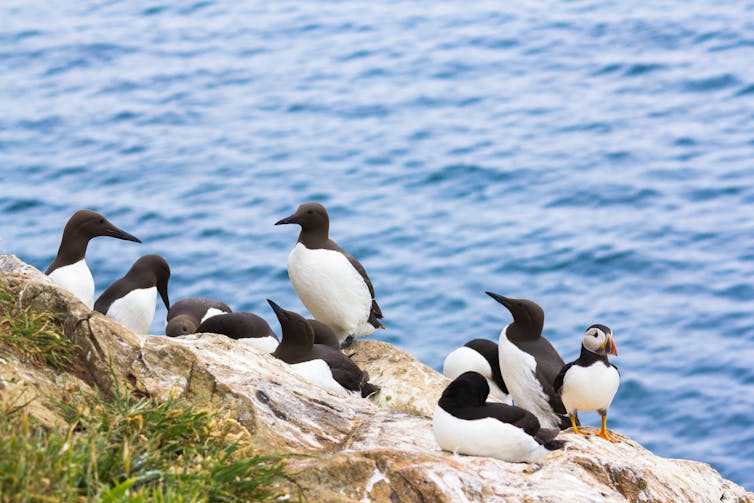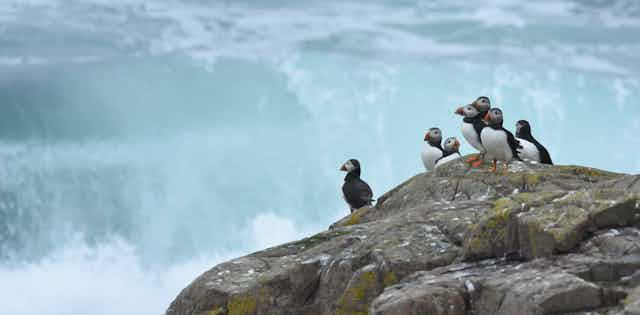The large colonies of seabirds that live on the coasts of Britain and Ireland have just been battered by three storms in one week: Dudley, Eunice and now Franklin. So what do storms like these mean for the birds that live in such exposed places?
Since 1972 my colleagues, assistants and I have been monitoring the survival and breeding success of guillemots on Skomer, a small island off the western tip of Wales. This project and others means we now have lots of data to help us answer this question.
We already know that seabirds are among the birds most affected by climate change, mainly because of climate-induced shifts in recent decades in the currents that carry the plankton that feed the fish that feed the birds. In affected regions, food supplies are simply too far from the colonies to make breeding feasible. It as though for us, we once had a supermarket round the corner, but it is has now moved 200 kilometres away and we have no car.
Under such circumstances, seabirds may fail to breed at all or they may somehow acquire sufficient food to produce eggs, but not to rear their chicks. For example virtually all guillemot chicks on the Isle of May in Scotland starved to death in 2007. For several years, many puffin chicks in Norway starved to death.
Deprived of the fish species on which they usually reared their chicks, some seabirds resorted to bringing hopelessly inedible, indigestible, nutritionless pipefish for their chicks – which they rejected. Puffins in some areas were forced to bring beakfulls of completely inadequate watery larval fish for their chicks. Seabird numbers in these regions have plummeted.
Repeated storms lead to seabird ‘wrecks’
But in addition to these long-term effects there can be short-term effects, induced by storms. Between late December 2013 and February 2014, for example, a succession of storms resulted in the death of at least 50,000 seabirds around the coasts of Europe, mainly puffins and guillemots.
The incidence of winter storms is thought to be linked to climate change. Seabirds have evolved to live with stormy winter conditions and can withstand the occasional storm, usually by riding it out on the sea surface. But storms in rapid succession often result in “wrecks”, when emaciated seabirds wash up on the shoreline (or sometimes far inland). This especially affects birds in the auk family, like puffins, guillemots and razorbills.
We still don’t know exactly how storms result in wrecks. Undoubtedly, high winds and heavy seas mean the birds have to expend more energy just keeping alive, but it also seems that storms make normal food supplies inaccessible, possibly because fish and plankton become dispersed. A lack of food together with increased energetic demands results in many birds starving to death.
Severe storms are almost unheard of during the seabird breeding season, which in the UK usually runs from May to July. However in May 2021, at a time when most seabirds were incubating their eggs, the UK and Ireland were hit by two storms. This meant that guillemot breeding that year on Skomer was among the least successful in our five decades of monitoring.

Some guillemots had their eggs washed off low ledges by high seas; others were forced to abandon their eggs temporarily during or after the storms, and some of these eggs failed to hatch. For guillemots, reduced breeding success in one year has little effect on the overall population. In contrast the loss of adult birds, such as those that die during storms, has a much greater impact. Guillemots, like most other seabirds, live for a long time (up to 40 years), and are not meant to die young.
The combination of long-term shifts in food distribution, the increase in the frequency and severity of winter storms, and more recently the occurrence of severe weather during the breeding season, all conspire to depress our seabird populations.
Even though it has been known for decades that a severe autumn or winter storm can result in seabird wrecks, their low frequency had meant that it was not possible to predict with any precision the occurrence of wrecks. However, in early 2014 as I watched the TV weather forecast warn of a third approaching storm, I felt sure there would be wrecks, as indeed there was. Ironically, there will probably soon be sufficient data to allow us to predict wrecks. What is needed of course to save our seabirds from further losses is the reduction in greenhouse gases that drive climate change.
On the basis of past experience, it will take a week or two before we can tell whether the innocently named Dudley, Eunice and Franklin will have killed yet more seabirds.

Don’t have time to read about climate change as much as you’d like?
Get a weekly roundup in your inbox instead. Every Wednesday, The Conversation’s environment editor writes Imagine, a short email that goes a little deeper into just one climate issue. Join the 10,000+ readers who’ve subscribed so far.

